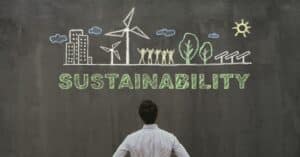Innovation has always paved the way to a thriving, competitive and profitable business. The ability to create new products and find solutions shows that a business is forward-thinking, one step ahead of the pack.
Today, the business world is changing – and such innovation is now an essential component of any business’ sustainability strategy. But it’s no longer just to make a profit.
What is sustainability?
The challenges of climate change mean that governments around the world are under pressure to meet net zero targets and keep rising global temperatures under control.
Consequently, there have been changes in environmental legislation that put pressure on businesses to help the government achieve its goals on reducing emissions and waste.
According to the United Nations, sustainability is defined as “meeting the needs of the present without compromising the ability of future generations to meet their own needs”.
There are three pillars of sustainability under this definition: environmental, social and economic.
The environmental pillar’s aim is to help companies reduce their carbon footprint, while the social pillar focuses on the impact on people and the economic pillar on profit-making and ethical governance.
What are businesses doing about sustainability?
Many businesses have responded by employing sustainability managers to undertake sustainability audits – investigating the business’s activities, identifying issues and solutions, monitoring and reporting findings.
In some cases, the actions of businesses to help the environment have been exposed as greenwashing.
But businesses are now under pressure to prove they are adopting Sustainable Business Model Innovation to meet the challenges posed by climate change.
Adopting Sustainable Business Model Innovation (SBMI)
Sustainable Business Model Innovation (SBMI) is the term for how a business harnesses innovation and technology beyond driving profit.
Under such an SBMI initiative, a business’ aim is to generate value that is not only financial but also of value to society and the environment.
Increasingly, businesses are seeing the benefits of sustainable business models. But this realisation is also being driven by pressure from government, employees, competitors and consumers.
In today’s world, the challenges posed by climate change mean the global economy must become sustainable in order to meet human demands and needs without harming the world they live in.
Using innovation and technology to drive your sustainable business model
For businesses to become sustainable, it is vital they harness new technology and innovation to make themselves more agile in responding to future environmental challenges.
A “business as usual” approach will most likely lead to a company eventually becoming extinct.
In any case, why would a forward-thinking company deny itself the wealth of opportunities available for growth, reputation and survival?
The chance to re-invent products and services, make processes cheaper and more efficient, reach new markets and reduce risk now runs parallel with the chance to solve common problems, find green solutions and do good for humanity as a whole.
What are the challenges of having to innovate?
Change in any business tends to come with associated extra costs.
Research and development can be expensive pursuits. Innovation often naturally involves a lot of trial and failure before success is reached.
Some larger corporates have managed to side-step this risk by acquiring smaller companies such as start-ups, who have often gone through this process themselves and found successful solutions that can be exploited by the larger company.
Companies can also re-energise employees and inspire them towards innovation by equipping them with green skills and sustainability knowledge.
At TSW Training, we offer a range of IEMA courses of varying levels and lengths to help businesses meet sustainability demands while expanding their market share.
Examples of companies using SBMI successfully
One of the main aims of the global sustainability initiative is to achieve a circular economy.
A circular economy essentially follows the principle that one man’s trash is another man’s treasure. Therefore, the waste created through one process can be harnessed to become useful to the same business (perhaps in another department), or be passed on to benefit another business or even help create a new product.
Example: Second hand fashion
One example of this is how the enormous waste involved in clothes production has been harnessed to create sustainable fashion apps, where second-hand items are not discarded but rather sold and purchased through websites and apps such as The Vestiare Collective.
Another objective for sustainability is the growth of the sharing economy.
Similar to the circular economy, where a discarded item is passed on to another consumer, the sharing economy works to the mutual benefit of two or more participants, usually involving a service rather than a product per se.
Example: Airbnb
For example, the proliferation of Airbnb properties across the globe means that existing properties can be rented out in the short term, raising funds for both the homeowner and Airbnb, while also providing accommodation for tourists.
This comes with the added benefit of the tourist avoiding comparatively higher costs of hotels and the associated impact of hotel emissions and waste on the environment.
Green products can also form part of the circular economy, where waste such as paper is recycled and turned into a new product through the use of new technology and innovative design. Modern technology allows businesses to re-think their production processes and materials, with the aim of creating something new, more attractive to consumers and with less impact on the environment.
Example: Biofuel
Green design might involve the creation of a new product such as Biofuel rather than the re-use or multiple use of an existing one. But it is perhaps the best example of business innovation and use of technology to meet sustainability demands.
Although the research and development involved in testing products such as biofuel can be long and costly, such innovation can greatly increase a business’s competitiveness and appeal to consumers.







